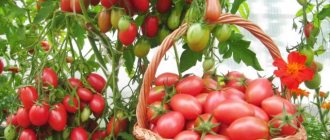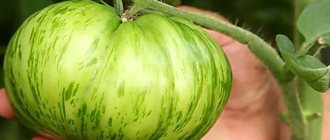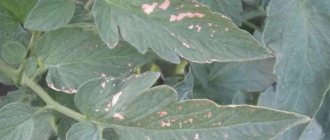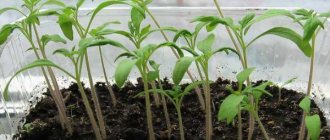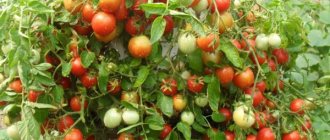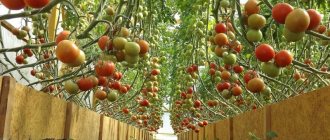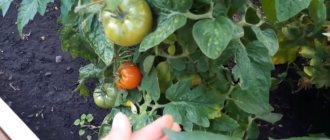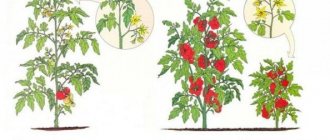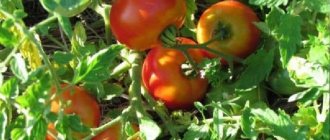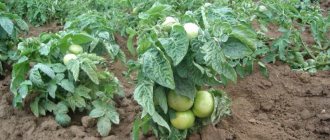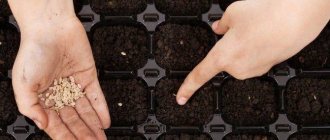What are standard varieties?
To the question of what a “standard” variety of tomatoes means, the correct answer is this: this is a relatively new and original branch of the group of determinate varieties and hybrids, characterized by short stature and compact bushes, automatic cessation of growth upon ripening, amazing unpretentiousness and high yield.
Have questions?
Ask and receive useful advice from professional gardeners and experienced summer residents.Ask a question {amp}gt;{amp}gt;
The popularity of tomatoes of this type among gardeners all over the planet is incredible. Firstly, their cultivation is so simple that, according to someone’s apt expression, standard varieties of tomatoes received the funny nickname “tomatoes for lazy people.”
Secondly, they are resistant to adverse weather conditions - and where the fruits of traditional varieties freeze or crack, these will remain intact. Finally, planting them means getting a harvest of fresh and ripe tomatoes for the dinner table when other varieties don’t even think about getting juice.
Visually, their bushes look like low, spreading trees, since the stem is characterized by significant thickness and strength, and the crown is compact.
Their root system does not go deep into the ground, and therefore planting is quite possible even on thin-layer soil. At the same time, these tomatoes require almost no special care or even pinching.
However, varieties for open ground must be planted taking into account the climatic characteristics of the region (of course, for film tunnels this limitation is not so important).
Benefits of tomato
The standard plant, which this variety of tomatoes belongs to, does not need to be tied up. Low bushes do not require special care. The advantages of tomato are difficult to overestimate:
- The variety tolerates picking well.
- Does not die from drought.
- Develops at low temperatures.
- Practically does not form stepsons.
The roots of the plant do not go deep, but feed on moisture and nutrients that are located near the surface of the earth. The bushes are planted at a closer distance than tall varieties, which helps to increase the yield per 1 square meter.
The tomato does not have to spend a lot of energy on the development of stepsons, so inflorescences appear faster and the ovary forms on them. Tomatoes do not spoil for a long time, are not damaged during transportation, and retain their presentation.
See also
Characteristics and description of the Lentyayka tomato variety, its yieldRead
The characteristics of the variety and ease of care attract not only summer residents and gardeners, but also farmers who grow tomatoes for sale.
Standard varieties of tomatoes - what are they?
First of all, standard tomatoes are low-growing tomatoes. But this is only one sign, the simplest one. What does stunted mean? Not all low-growing varieties are standard varieties. The criterion for short stature is quite simple: all standard varieties grow as bushes, the height of which is from 25 to 60 cm. All, with a few exceptions, standard varieties belong to the group of determinant, that is, their growth stops at a certain stage of development.
However, short stature is only one sign. As a rule, standard tomatoes have a very developed, but shallowly located root system and a powerful, although short, main stem with a small number of branches. This trunk is almost like the trunk of a fruit tree: fruit branches begin at a low height, and the “trunk” holds the bush well, until a certain time, or even without requiring tying up at all.
Externally, standard tomatoes can be recognized precisely because they look like small trees with a thick, strong stem and a dense crown. They require almost no shaping, not even pinching. Most of these varieties bear fruit with relatively medium-sized tomatoes (weighing no more than 150 g), most often round in shape. However, with the development of breeding, the last sign is increasingly becoming incorrect.
Standard tomatoes are low trees hung with fruits.
Thus, it is apparently impossible to give a clear definition of standard varieties, but the appearance of the bush can most often easily answer the question of whether the variety should be considered standard.
Characteristic varietal characteristics and description
Despite the fact that the Dubok variety was bred back in the USSR, its remarkable characteristics convince gardeners to grow these tomatoes today. Between the dense foliage of the bush, the hefty bunches of tomatoes amaze even experienced agricultural technicians. Ripened Oak is endowed with a bright red color and a rounded shape, has good taste and the presence of a refreshing sourness. The main characterizing indicators are:
- early ripening of tomatoes;
- the height of the bush reaches 70 cm;
- it grows into a powerful bush and is not a standard tomato;
- feels great when formed into 3 or even 4 stems;
- the oak variety does not produce an excessive number of stepsons.
Features of cultivation and formation
Features of standard varieties of tomatoes, such as early ripening and bush shape, also leave an imprint on their agricultural technology: from sowing seeds to harvesting. So, most of these tomatoes in many regions of the country can be grown without seedlings, sowing the seeds directly into the garden bed. True, in this case, the advantages of precocity will be missed, so this approach is implemented only in the south.
To realize the possibility of obtaining early harvests, seedlings are still grown. The seeds are sown in boxes in such a way that the seedlings are about one and a half months old when they are planted in the ground. Since seedlings of standard tomatoes grow very short, when planting them in a garden bed it is easy to cover them with spunbond for the first time, so planting in open ground is possible 7–10 days earlier than in the case of tall varieties.
Since the seedlings grow very compact, and these tomatoes take root in the garden easily, there is no need to grow each bush in a separate pot or cup: seedlings at the stage of two true leaves can be planted into a larger common box according to the 5 x 5 cm pattern, saving space on the windowsill .
Seedlings of standard varieties will grow well in a common box
Despite the relative cold resistance of standard varieties, the seedlings begin to be hardened a week before planting in the garden bed, taking them out into the fresh air for a while. As a rule, when planted in the ground, seedlings are already blooming, and if they are a little late, they may have the first few tiny ovaries. Standard tomatoes are planted quite densely, but this is not entirely justified.
The fact is that the roots of these tomatoes are in the surface layer, and therefore spread mainly to the sides and require a feeding area of approximately 40 x 50 cm. Therefore, denser planting will not always bring a significant gain in overall yield. However, most gardeners plant seedlings of standard tomatoes every 30 cm, leaving 50 cm between rows. Such tomatoes are planted infrequently in greenhouses, and if they are planted, they try to compact them even more, using a checkerboard pattern.
They try to immediately fill the bed for standard tomatoes well with fertilizers: in this case, most often you can do without fertilizing. If you were unable to dig up the garden bed in the fall, you don’t even have to do a complete digging. You can dig an individual hole under each bush, putting 2-3 cups of humus and a handful of wood ash in it.
Standard tomatoes are planted quite densely
Plants continue to grow almost immediately: adaptation of standard tomatoes to a new location takes only 2–3 days. The irrigation regime for them is somewhat different from that for tall varieties. This is due to superficial roots. These tomatoes do not require much water, but the surface layer of soil must be kept moist all the time.
If the bed is well-filled, standard tomatoes do without feeding, otherwise they only have to be fed twice: 10 days after planting the seedlings and another two weeks later. The first time it is better to use mullein infusion, the second time - wood ash. If there are no natural fertilizers, then any complex mineral fertilizer and any potassium salt.
Not all varieties of standard tomatoes have to be tied up: many do not lie on the ground even under the weight of the harvest. Otherwise, tying is advisable; however, this is not difficult to do: it is enough to tie the plant to a low peg in just one place. It is especially important not to let the bushes fall to the ground if slugs are rampant in the garden.
Some varieties of standard tomatoes require pinching; this should be written on the seed package. But even they give few stepchildren and manage quite well without this operation. These tomatoes do not require bush formation as such. However, as the fruit grows, the lower leaves should be removed, especially if they turn yellow.
When the tomatoes begin to ripen, it is advisable to pluck out the leaves that protect them from the sun. Finally, if there is too much flowering, some of the flowers that formed later than others should be removed. However, all these are optional events, and busy summer residents can simply forget about them: maybe the harvest will be smaller, but it will be guaranteed.
Only some standard varieties require bush formation; it is carried out according to the schemes for determinants
Caring for standard tomatoes is easy, but they are not protected from diseases. Although, for example, late blight does not threaten most varieties: by the time the weather turns bad and brings this disease, the harvest will already be harvested. Prevention of other diseases mainly consists of the use of Fitosporin:
They try to drive away pests by sowing fragrant herbs and flowers (basil, coriander, marigolds, nasturtium, etc.) in neighboring beds. Periodic dusting of the beds with dry ash or ground pepper gives a good effect. The hardest thing to deal with is slugs; They try not to scatter metaldehyde-based chemicals over the garden bed; if there are a large number of these pests, special traps are used.
A number of other features are also characteristic of such varieties:
- the compactness of the plants allows you to plant twice, and sometimes three times as many bushes on the same area - and, accordingly, reap a rich harvest;
- most varieties are suitable for planting in open ground even in central Russia - while in a similar time period, other varieties of tomatoes can only develop in greenhouses;
- since the root system of these tomatoes is shallow, they are successfully grown even in containers;
- almost simultaneous ripening is very convenient for housewives who practice quick and mass canning for the winter;
- their low height means that there is no need to tie up the bushes (this can only be done to prevent the lower fruits from falling to the ground - which, however, does not in any way affect their integrity and taste)
- standard tomatoes are not only very productive, but also tolerate drought well;
- They are not particularly afraid of low temperatures;
- another reason for the high yield is the almost complete absence of the appearance of stepsons;
- seedlings take root in the soil very reliably if they are not allowed to overgrow. And the small size of the bushes contributes to successful cultivation even on the balcony or windowsill of a standard city apartment;
- finally, the last main difference between these tomatoes and traditional ones is long-term storage and safety during transportation.
It is not surprising that for these reasons, gardeners have only positive reviews of standard tomatoes (both large-fruited and small-fruited).
Thanks to the root system, which is located close to the surface, the bush of this type of tomato is formed quickly, and you will need the following actions:
- removal of the lower leaves and stepsons throughout the entire growing season (as a result, the bush will produce about 7-8 almost simultaneously ripened brushes);
- the leaves in the lower part of the bush begin to be removed when the plant reaches a height of about 20 cm - but you should not get carried away;
- It is recommended to monitor the crown as follows: select the central, thickest and most durable stem, and pinch off all the stepsons, flower ovaries and small fruits outside it;
- in addition, it is better to remove the lower leaves under those fruits whose ripening has entered the final stage;
- pinching (taking into account planting in late April - early May) is enough to be done weekly, and after 1.5 months, pinching the tops and waiting for the fruits to fully ripen;
- It is better to perform all the above procedures in the morning and only in dry weather, since a wet cut can become a source of infection.
Tomato Udachny - description and characteristics of the variety
Variety property
Having learned about the main features of the variety, even a student gardener will be able to successfully grow a large number of tasty tomatoes.
- Determinate bushes reach a height of 60 to 80 centimeters.
- Each cluster is tied with 7 to 9 fruits.
- The first tomatoes ripen 95-105 days after emergence.
- the fruits are round in shape;
- more than enough of each tomato reaches from 150 to 200 grams;
- red patina;
- the skin is dense;
- tomatoes have excellent taste characteristics;
- fruits are easily transported;
- the harvest is stored for 1-1.5 months.
That is, plant and care for the plant
Tomatoes of this variety are suitable for growing in open beds, as well as in film shelters. In the first part, seedlings are grown. To make the bushes stronger, it is advisable to extend the picking of the seedlings. This should be done after two true leaves have fully formed. Ten days before the planned transfer of seedlings to a permanent area, it is recommended to harden the seedlings. To do this, she needs to be dragged out into the open air for several hours. You can place containers on top of a balcony or veranda. Hardening will facilitate faster adaptation to transfer to a garden or greenhouse.
Like many other nightshade species, the Successful variety loves good light, for this reason it should be planted in places that are accessible to sunlight. It is better to provide protection from gusts of wind.
The bushes do not need shaping. Stepchildren can be deprived as needed. More than six bushes are planted on one square meter. As preventive measures against vegetable crops being damaged by diseases, it is necessary to periodically weed, loosen and hill up the planting beds. It is better to water the plant in the evening, using warm water.
Productivity, scope
According to reviews from experienced gardeners, it is possible to harvest up to 3.5 kilograms of ripe tomatoes from one bush. However, this is possible if you carry out all the necessary agrotechnical measures.
The scope of application for tomatoes of this variety is universal. Housewives successfully use them for canning valuable fruits, and in addition for preparing a variety of dishes. Sauces, pastes, and tomato juices are prepared from them. They are also suitable for fresh consumption, as well as in vegetable salads. Barrel pickles are incredibly tasty.
Disease resistance
Tomato variety Good has good resistance to diseases such as root and apical squabbles. To prevent the development of other diseases, preventive measures should be taken and the plant should be treated with special means.
Advantages and disadvantages of the variety
Many vegetable growers choose Udachny tomatoes every season, because they have many more positive qualities than negative ones.
As always, the advantages include the following:
- High yield.
- Resistance to the most common diseases.
- Absintheism is the need to form a bush.
- Tomatoes do not crack, have a long shelf life and are easily transported over long distances.
Of the disadvantages and inconveniences when growing, gardeners note only that in order to prevent pests and diseases, the plant must be periodically treated with special means.
Reflections of gardeners
For beginners, the opinions of experienced vegetable growers are very helpful in deciding whether the variety they like is worth planting on their plot or is shining by its absence. Tomatoes of the Udachny variety have mostly positive reviews. They are valued for their excellent taste, low maintenance requirements, and long shelf life.
Every garden owner has pet tomatoes. Those who have grown the Blestyaschiy variety are in most cases satisfied and recommend it to all their friends and acquaintances.
Pros and cons of standard varieties
The number of available varieties of standard tomatoes is more than a dozen, each of them has its own advantages and disadvantages. At the same time, all these varieties have something in common, for example, similar approaches to planting and growing. If you try to name the general pros and cons of all standard varieties, you will get quite impressive lists. The advantages of standard tomato varieties are:
- almost complete absence of stepchildren;
- a powerful, thick and short stem, which in many cases allows you to do without tying up the bushes;
- well developed root system;
- compactness of plants, allowing compact planting;
- easy survival of seedlings;
- resistance to changes in air temperature and soil humidity;
- suitability for cultivation in open ground;
- early ripeness;
- uniform ripening of the main part of the crop;
- good transportability;
- possibility of growing in apartment conditions, including on the balcony.
The disadvantages of such tomatoes are:
- not always excellent taste;
- relatively low yield;
- insufficient resistance of many varieties to diseases and pests;
- the possibility of suppressing seedlings by weeds when sowing seeds in open ground due to slow growth.
Standard varieties are very popular due to their ease of care, early ripening and almost simultaneous ripening of the crop. At the same time, these varieties are not for gourmets: most of them are used primarily for pickling or canning, and also as the first tomatoes of the season. In the second half of summer, non-standard salad varieties are more suitable for fresh consumption.
Tomato Summer resident: variety description and characteristics
The Dachnik tomato was bred by Russian breeders, and this variety was included in the state register of our country in 1999. The seeds are produced by Agro, but many producers today are breeding this variety. But do not confuse the Dachnik tomato variety with its hybrids of the same name, the seeds of which are produced by Aelita; remember, these are completely different crops. Due to the simplicity of the name, many varieties currently have the prefix summer resident. For example, the Kuban Summer Resident tomato or the Ural Summer Resident tomato, as well as a number of other varieties. This is why many gardeners confuse the real Summer Resident with other varieties and hybrids. Remember that these are also different plants.
It is recommended to grow it in the North Caucasus, in the central regions, even in the Urals and Siberia. This variety is considered determinate, so it does not necessarily need to be pinched; the bushes are compact, reaching a height of 60 centimeters. Therefore, there is no need to tie up the plant; it is a matter of taste. Make sure that the fruits do not gain too much weight if you do not want to install supports near the plants. Otherwise, the stems may break and the Dachnik tomatoes themselves may die. Seedlings of these tomatoes are usually strong and stocky, and the bushes always maintain a compact appearance. It is precisely because of this unpretentiousness to growing conditions, as well as because of the compactness of the plants, that summer residents love these tomatoes. An interesting fact is that due to its short stature, this variety of tomatoes can even be grown on the balcony.
Tomatoes Summer resident: photo of variety
Despite the fact that the Dachnik tomato variety was seen for growing in open ground, many gardeners plant these tomatoes in greenhouses, as well as under shelters. But remember that even in unfavorable weather conditions, tomatoes ripen well, so they feel great both in a regular garden bed and in a greenhouse. The inflorescences of these tomatoes are simple; no more than 10 tomatoes are usually formed in one cluster. Another undeniable plus: tomatoes are classified as early ripening, so you can count on an ultra-early harvest. You can collect the first fruits within 85 days from the moment the first shoots appear. But usually it is best to harvest tomatoes at 90 or 95 days.
Despite the simplicity of the variety, the yield of the Dachnik tomato is quite high. Especially considering the fact that tomatoes bear fruit very early. From one bush you can collect approximately 3 kg of ripe and fragrant fruits, and if you take good care of your tomatoes, you can get more than 4 kg of harvest from one plant. Often these tomatoes are grown on an industrial scale, with approximately 350 centners of fruit obtained from one hectare. Tomatoes have excellent presentation, so they can often be seen on shelves in grocery stores. These tomatoes are also very resistant to temperature changes, as well as diseases and pests. For example, there is practically no blossom end rot on fruits, but, meanwhile, some plants suffer from late blight. However, it should be said that due to the early ripening of the variety, plants usually do not suffer from this disease, since they produce the entire harvest before the moment when this disease begins to develop on the site.
Tomatoes Summer resident: photo of the variety
The Dachnik tomatoes themselves are standard, round, without visible ribbing. At first, the tomatoes are light green, and during the period of technical ripeness they become bright red. The tomato pulp is pink-red, fleshy, not hard, quite juicy, but the skin is usually thin. There are a large number of seeds in the Dachnik tomato variety. The fruits are always tasty and aromatic, they contain a lot of dry matter. As you remember, this is not a large-fruited crop, so tomatoes are small in size, and the weight of one tomato is usually no more than 100 g. The pulp of a tomato is always sweet with a slight sourness. They contain more than 3% of the bulk of tomatoes. It must also be said that the pulp even contains ascorbic acid, which is very beneficial for humans.
As you remember, Dachnik tomatoes are universal, which is why housewives love them so much
They can be consumed both fresh and processed; it is especially important to note that these tomatoes are ideal for any preparation, they are stored well, so they can be transported over long distances. It should be noted that Dachnik tomatoes usually ripen unevenly, their fruiting is extended, so you can count on a ripe product throughout the summer-autumn season
Also, you will not need to rush through processing, the crop will ripen sequentially, in small portions, and you will be able to collect tomatoes and process them when you have free time.
Tomato growing technology
After purchasing seeds, they are treated with potassium permanganate. They can only be planted in the garden when the soil has been sufficiently warmed by the sun's rays. Until this moment, you need to prepare the bed itself. It is raised in height and expanded, arcs are installed along the soil. The bottom is covered with any grass, and humus is placed on top, which is mixed with ash flour.
The holes in the garden bed are made in a checkerboard pattern. Every 0.3 m you need to place 4-5 seeds. Then they are sprinkled with a layer of earth 12-15 mm thick. The soil is watered with a warm solution of potassium permanganate. All holes with seeds are covered with jars. A film covering is stretched over the previously laid arcs, which is sprinkled with soil on top to hold the polyethylene in the wind.
The bed is opened only after the seeds have germinated. When the tomato bushes grow to a height of 8-10 cm, no more than 2 sprouts are left in the hole. This method of planting reduces the time required to care for the tomato. The plant bears fruit until cold weather, and its stems and leaves resist late blight well.
This tomato is not afraid of verticillium disease and fungal infections. Watering the bushes is recommended only during extreme heat or drought.
To protect tomatoes from garden pests, such as aphids or caterpillars of various insects, spraying the bushes with toxic chemicals is used. Slugs are destroyed by treating the soil under the bushes with ash flour.
It is difficult to describe all the available varieties of standard tomatoes: apparently, their number can be estimated at about a hundred. This or that gardener prefers one or another variety: depending on the shape of the fruit, color, taste, purpose, etc. In addition, not all varieties are intended for all regions, although in most cases there are no restrictions in this regard. The list of the most popular is as follows.
Far North
A variety for universal use. The tomatoes are round, with small ribs, medium-dense, red. The weight of the fruit is about 80 g, the taste is assessed as good. Productivity up to 2 kg/m2. The variety is resistant to various rots.
Tomato Far North, according to the name, is quite cold-resistant
Buyan (aka Fighter)
Variety of universal use. The fruits are cylindrical, red, weigh up to 90 g. The taste is good, the yield is up to 2.3 kg/m2. Tomatoes “reach” well during storage. The variety is resistant to droughts, as well as to the most dangerous disease - the tobacco mosaic virus.
Buyan tomato is ideal for whole-fruit canning
Shuttle
The variety is not approved everywhere, only in the Central, Volga-Vyatka and West Siberian regions, but is known everywhere. The purpose of the harvest is universal; the fruits ripen together. They have an elongated oval shape and are red in color. The weight of the fruit is 45–55 g, the taste is assessed as good. A variety for industrial use, up to 792 centners are collected per hectare, suitable for mechanical harvesting.
Tomato Chelnok is one of the few standard varieties grown on an industrial scale
Salad super early variety. The fruits are round, red, weigh up to 80 g, and have good taste. The yield is quite good, ranging from 6–7 kg/m2. The not very high taste characteristics of Alpha fruits are more than offset by very early ripening and decent yield.
Tomato Alpha is a high-yielding variety that is one of the first to ripen
Amur standard
A very early standard variety, universal purpose. The fruits are flat-round, with slightly pronounced ribbing, red in color, weighing up to 70 g. The taste of the tomatoes is excellent, the yield is up to 4.8 kg/m2. The variety is characterized by increased resistance to verticillium.
The Amur standard tomato bears fruit with very tasty tomatoes.
Bullfinch
The Snegiryok tomato is often grown in the form of a potted crop on a windowsill or balcony. The purpose of tomatoes is mainly salad; the fruits are characterized by excellent taste. They are round, medium-dense, red, weighing no more than 30 g. The yield when grown in beds is about 3 kg/m2.
Tomato Snegiryok is often grown at home
Altaechka
Salad variety with ovoid, ribbed, medium-dense fruits. The tomatoes are quite large, weighing 110–130 g, raspberry in color, good taste, and the harvest is characterized by excellent transportability. Productivity is about 8 kg/m2.
Tomato Altaechka has very good yield
Flame Agro
A salad variety. The need for plant formation and obligatory gartering of bushes is stipulated. The tomatoes are round, medium-dense, red, of excellent taste. The weight of each fruit reaches 120 g, the yield is 4.5 kg/m2.
Tomato Flame Agro, unlike many standard varieties, is quite large-fruited
Boni-MM
Super-early salad tomato variety Boni-MM, ripens 83 days after the first shoots. The fruits are flat, with noticeable ribbing, weighing about 60 g. The taste is good, the marketable yield is quite decent: up to 6.5 kg/m2.
The Boni-MM variety does not have the most delicious tomatoes, but they ripen almost the very first
Yamal is a universal variety. The fruits are flat-round in shape, with clearly visible ribs. The tomatoes are red in color, weigh up to 90 g, and taste is rated as good. Productivity 5.6 kg/m2. Characterized by increased resistance to various rots.
The Yamal variety does not stand out in anything special, but overall it is not bad at all
Belogorsk cream
Salad variety with cylindrical red fruits, weighing up to 90 g. The taste is good, the yield is 6.5 kg/m2. The variety has high, compared to many standard varieties, resistance to most diseases, including viral ones.
Tomato Belogorskaya cream is one of the most disease-resistant
Description of culture
The Amur standard tomato, photos and reviews of which are presented below, is distinguished by its early ripening period, because the first fruits begin to ripen 85-90 days after sowing the seeds. Despite the fact that this variety is recommended for growing in open ground, it can also be grown on a balcony, loggia, and even in greenhouse conditions.
Due to its early ripening, this variety of tomatoes can be grown in open ground without seedlings. However, this method is not suitable for all regions. In areas with a harsh climate, it is still advisable to grow seedlings in order to harvest on time. According to the description of the variety, the Amur standard tomato does not require care.
Plants have a high rate of growth. Immediately after germination or transplanting of seedlings, the bushes quickly gain green mass. In a few weeks, the entire bush will be covered with small, green tomatoes. From 25 to 35 fruits are formed on one plant, which ripen quite quickly.
A distinctive advantage of the variety is the ability of tomatoes to ripen equally well both in sunny weather and in the rainy season. Low, strong tomato shoots do not need tying up. Stepson formation is moderate.
The root system of a tomato is located superficially. The stems of the bushes are strong. The leaves, which are dark green in color, are quite large for such short plants. The originators of the variety recommend planting at least 5-6 plants per m².
Description of fruits
In the active growth phase, the fruits of the Amursky Stamb variety are light green in color, but in the full ripeness phase they acquire the traditional bright red color.
Flat-rounded fruits with dense pulp have a rather pleasant taste. The weight of tomatoes can vary between 60-120 grams.
Text version
July 7 sur tomato Amur standard is a very early, low-growing, compact tomato variety that does not produce practically a stepson. It will melt only up to about 40 centimeters and is good for open.
The best varieties of tomatoes from last season
Soil even for cold areas. Due to the climate, the fruits have slightly different shapes, are they more flattened? There are more round ones, but the flesh is dense and quite tasty; fruits weigh from 60 and are there individual ones?
Up to 120 grams they are resistant to both cool and gentle conditions and drought, but this year they still cracked! Used mainly fresh in salads, but they are also suitable for pickling July 19, 2019 a variety of undersized tomato that is not ripe!
#the most productive varieties of tomatoes
It is called cupid and standard because of my bush.
Video: Replenishment of the collection of the famous MINUSINSK TOMATOES!
Video: 10 BEST LOW GROWING VARIETIES OF TOMATOES FOR OPEN GROUND. According to reviews from gardeners
I’ve already picked tomatoes twice, now I’ll pick them again, which I want to say taste delicious with tomato flavor and aroma.
The most productive varieties of tomatoes
Well, the frets are of different shapes, like most varieties this year, is each grazing fruit actually cracking? Cracked, well, I want to tell me there are subscribers, she lives somewhere. Near Surgut, she asks me what tomatoes to grow, how many brushes you insert.
So then this is what I want to advise her, try it, I already advised her that you only need very early ripening varieties like her. He says I’ve been planting it for several years and have never received any tomatoes. So try to sow and grow this very early ripening tomato, I’m saying this for the third time.
The most productive varieties of tomatoes
There will be a harvest, you see, these were all tomatoes, a very early ripening variety of tomato.
Amursk is like a barn and it is kind of ugly in appearance, but the tasty tomato is quite tasty. Like at home, they told me it’s a real typical lipstick with its own smell and taste, so I hardly think it’s like this from the Amur standard one.
#
Whether I will grow it because there are more worthy varieties, it doesn’t seem to me for cold ones: Regions, this variety should go for uranium, try weaving Moto Amur standard overseas, the disease can be said to be resistant.
Varietal characteristics of tomato Amur shtamb
Before making a choice in favor of one or another variety of tomatoes, every vegetable grower carefully studies their varietal characteristics. We present to your attention a list of distinctive features of tomatoes of this variety in order to fully appreciate its pros and cons.
A distinctive characteristic of the variety is the rather small number of stepsons formed. Therefore, during the growth process, the plant directs all its forces to the formation and ripening of a large number of fruits.
Fruiting and productivity
Low tomato bushes have fairly good yield indicators. From small plants only 50-60 cm high, it is quite possible to harvest up to 4-4.5 kg of ripe and tasty tomatoes. However, these indicators can be significantly increased through timely application of fertilizing and compliance with the growing rules recommended by the originators.
